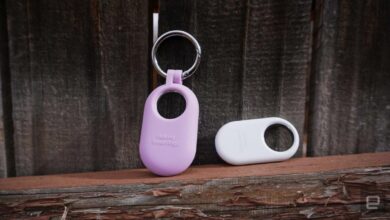
Dyson helped pioneer the cordless vacuum space, and now it’s testing the waters of the robot vacuum arena. The Dyson 360 Vis Nav has been available in other parts of the world for a little while, but it recently came stateside to the tune of $1,200. The company claims a 360-degree vision system, complete with cameras and LED lights, along with suction power akin to that of its stick vacuums sets the 360 Vis Nav apart from competitors. But even if that’s true, Dyson is undeniably late to the party. Robot vacuums have gotten a lot better in the past three to five years, and there are dozens on the market — including some that offer much more in the way of features for a similarly exorbitant price. That said, did Dyson pull an Apple and shake up a product category despite its late entry to the stage? I spent some time with the 360 Vis Nav to find out.
Setup and design
Unboxing and setting up the 360 Vis Nav is similar to any other robot vacuum. In addition to the device, the box contains a charging cable and the vacuum’s base, a rectangular, purple unit with two black-and-white checkered spots at either corner. While it’s refreshing to see a gadget that doesn’t wear the typical black or gray uniform, the 360 Vis Nav and its dock stick out like sore thumbs among the other items and furniture in my home. There’s no semblance of “blending into the decor” with this robo-vac.
Dyson’s first robot vacuum may be late on the scene, but it impresses with excellent suction power and remarkable obstacle avoidance. However, its $1,200 will be prohibitively expensive for some.
- Excellent suction power
- Impressive obstacle avoidance thanks to 360-degree vision system
- D-shaped design cleans room corners better
- On-device display provides handy setup and cleaning instructions
- Super expensive
- No self-emptying base
- No mopping capabilities
Once docked for the first time, the Dyson 360 Vis Nav’s small onboard display prompts you to choose a preferred language and get connected via the mobile app. The screen doubles as a button, too, so you can press fully down on it to select options and move forward in the setup process. As I learned while using the machine, the display also shows helpful maintenance tips and accompanying graphics when you need to clean the robot’s sensors. The My Dyson app (on iOS and Android) provides all of the same information and more, and will guide you to connect the machine to your home’s Wi-Fi network, update the firmware if necessary and finish the prerequisites before you get to cleaning. Aside from waiting a few minutes for my review unit to update its firmware, the entire process took me only about 15 minutes.
To get the lay of the land, let’s revisit the few things Dyson claims set the 360 Vis Nav apart from other robot vacuums. The D-shaped design isn’t one of them, but it certainly helps the machine’s side-edge actuator when cleaning room corners. Dyson claims the actuator only opens up when cleaning corners like this, and it uses suction (rather than sweepers like other robo-vacs do) to capture debris from these hard-to-reach places. Along with that, the machine has a 360-degree vision system that helps it map our your home and clean around furniture and other objects, plus a sensor that detects the amount of dust present so it can kick up the suction when necessary and create a heat map of the dirtiest parts of your home. Those are the main differentiators, along with the claim that the 360 Vis Nav essentially has a similar level of suction power as one of Dyson’s cordless stick vacuums.
Performance
So how did all of that come together in practice? Pretty well, as it turns out. For the initial go-around, I had the Dyson 360 Vis Nav clean the main floor of my home, rather than map it out first. I did this mainly because I like chaos, but also because I wanted to see how the machine would navigate around coffee tables, couches and other furniture, plus small things like cat toys left in its path. Dyson states very clearly in the setup process that you should remove all small obstacles out of the way of the 360 Vis Nav before it cleans — I picked up a couple of reusable bags languishing from our last grocery run and the smaller cat toys, but I left some charging cables snaking on the ground because, let’s be real, most people aren’t going to clean before sending the robot they bought to clean for them out to do its job.
I was quickly struck by how many times the Dyson 360 Vis Nav came to a complete stop, “looked” around and kept moving during the first cleaning. It did a decent job avoiding large pieces of furniture like chairs and couches because — when it did get close to pieces like that — it seemed to sense it a few inches before hitting it, so it could then stop and redirect itself. It was most confused by a coffee table with a supporting beam that runs on the floor in between two legs. The 360 Vis Nav has adjustable wheels that allow it to “climb” on top of things like thicker rugs when it’s cleaning, and I think it confused this roughly 0.5-inch supporting beam for a piece of decor. The robo-vac tried so hard to climb over it; it was borderline concerning, but I was rooting for it the whole way. It actually did manage to climb over the beam, get back down onto the floor and keep cleaning, so kudos to the little guy for never giving up.
After that thrilling show, I left the 360 Vis Nav to its own devices. It proceeded to clean the main floor of my home for almost an hour, audibly notching up the suction when it detected a messier area. Notably, it seemed better at avoiding furniture than other robot vacuum cleaners I’ved tried. Yes, it did knock into a few things, but the number of times that happened was slim to none. The first run I did was in Auto mode, the default cleaning setting and one of four you have to choose from, and while the machine was a tad loud, it’s nothing that will drive pets or young children from a room. It’s loudest when the machine automatically kicks the motor into high gear upon detecting a high-dust area, which it did a few times in the highest trafficked areas of my kitchen and on top of a few area rugs. Like any other robot vacuum worth its salt, the 360 Vis Nav automatically returned to its dock to recharge when the battery got low.
I deemed that first cleaning job a success, and the case was the same when I did the first mapping run. The 360 Vis Nav is much quieter when it’s puttering around your home not sucking up dirt, but rather just using its vision system to create a map of your home and all its furniture and obstacles. The map it created of my main floor was accurate, and the Dyson app makes it simple to add boundaries and create rooms that you can label. Once you do this, you can create no-go zones and other restrictions like cleaning without the brush bar. And like most other vacuums with smart mapping, you can tell the 360 Vis Nav to only clean certain rooms with each job if you please.
Like most other robot vacuums, the companion app experience focuses on home maps, schedules and basic on-off controls. Dyson lets you choose from Auto, Quick, Quiet and Boost cleaning modes before you start a job, and if you have rooms designated on your map, you can customize cleaning modes for each room every time. For example, I could tell the machine to clean my kitchen in Auto mode and then the den in Quiet mode. The app presents a heat map of your home after every job that highlights the areas with the most dust, which is interesting to look at but didn’t provide me with a ton of groundbreaking information. I was not surprised that the dirtiest spots on my main floor were almost always next to the front door and my deck door.
Ultimately, the two things that impressed me the most about the Dyson 360 Vis Nav were its suction power and its obstacle avoidance capabilities. I live in a one-cat household, but if you saw how much cat hair my cordless stick vacuum sucks up every time I use it, you’d think I live with a few more felines. There’s always more fur in the bin after I clean the upper floor of my home, since it’s carpeted. After leaving the 360 Vis Nav on my upper floor to clean for almost an hour, I was surprised to see that the contents of its bin looked nearly identical to that of my cordless stick vac after cleaning up there. Even the best robot vacuum cleaners I’ve used in the past never sucked up this much pet fur in one go-around on carpeted floors — it’s impressive.
As for obstacle avoidance, I didn’t expect much from the 360 Vis Nav in this department because the instructions tell you, more than once, to clear your floors of any obstructions before cleaning. Most of the time, I had at least a few pairs of shoes, a couple of charging cables and other small objects on the floor while the machine was cleaning, but I never once got an alert that it was stuck. Some robot vacuums I’ve tested have sent me close to a half dozen alerts during a cleaning job, and I’d have to remove an object they were choking on before they could start up again. That never happened with Dyson’s machine.
The competition
With the Dyson 360 Vis Nav coming in at an eye-watering $1,200, the competition squarely within that price range is pretty slim. The $1,400 iRobot Roomba Combo j9+ is arguably its most direct competitor and it offers quite a bit more for that extra $200. (We’ve seen the Combo j9+ drop to as low as $1,000 in the past, so you might be able to pick it up for even less than Dyon’s machine.) As a “combo” device, the j9+ vacuums and mops without the help of a human (mostly) and it’s smart enough to know when it needs to switch from sucking up dirt to mopping floors using its built-in scrubbing pad and water reservoir. It also comes with a self-emptying base that can hold up to 60 days worth of dry debris and refill the water reservoir with clean supply. While auto-mopping is more of a nice-to-have than a requirement on a robot vacuum, it’s painful that Dyon’s $1,000+ machine doesn’t come with a clean base — a piece of hardware included in some models half of its price.
Wrap-up
When you understand the lay of the robot-vacuum landscape, the Dyson 360 Vis Nav seems almost quaint — and a bit confusing. Robot vacuums aren’t new, they’ve been around for a long time — long enough where you can get a pretty decent one for less than $300. For Dyson’s machine, spending $1,200 gets you a damn good robot vacuum with possibly the best suction power I’ve experienced on one, impressive obstacle avoidance, good home mapping and a clean app experience. But none of those features are unique to the 360 Vis Nav. Its suction power and obstacle avoidance may be superior, but is that enough to justify the cost? If you’re already willing to spend $1,000 or more on a robot vacuum, you have other options that will give you similar features and more, including mopping and self-emptying capabilities. That said, there are two groups of people who I’d recommend the 360 Vis Nav to: those who are willing to give up advanced features in exchange for the most suction power possible (and have cash to burn), and Dyson diehards.
Source link




